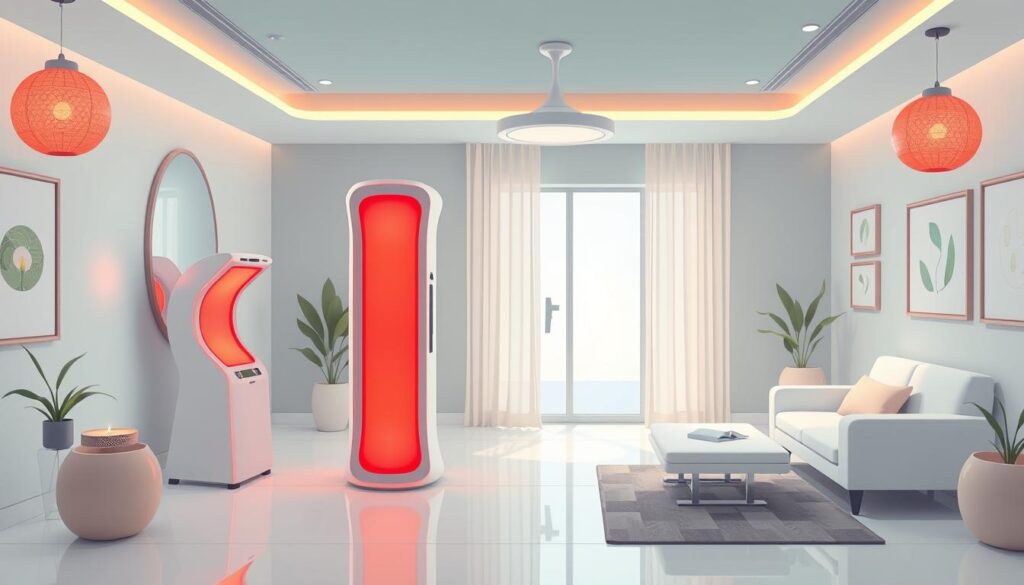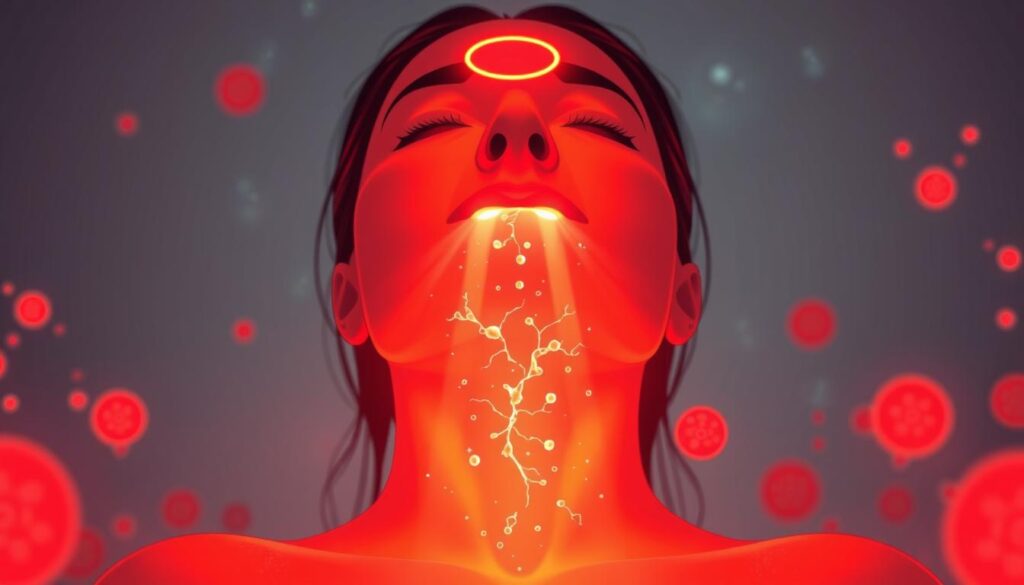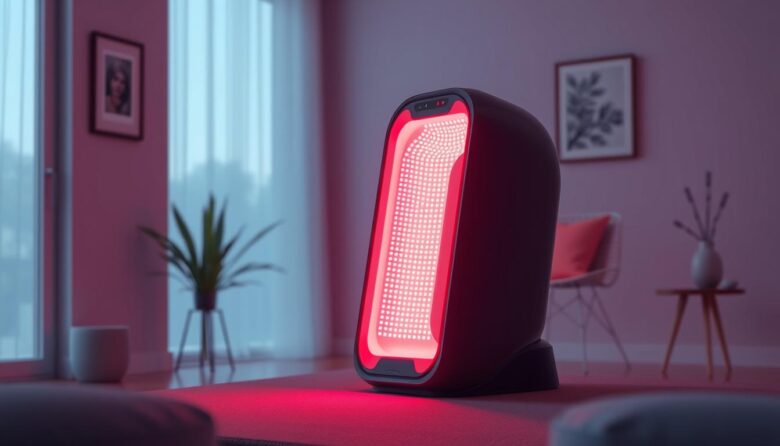Red light therapy (RLT) uses low-level red and near-infrared light. It helps treat skin conditions, reduces inflammation, and promotes healing. It’s also known as photobiomodulation, low-level light therapy (LLLT), and soft laser therapy.
In the 1960s, Hungarian physician Endre Mester discovered RLT’s benefits. He found it could help rats grow hair and heal wounds. Since then, RLT has grown in popularity, used for skin rejuvenation, pain relief, and even brain health.
RLT devices emit low-intensity red and near-infrared light. This light is thought to penetrate the skin and stimulate cells. It triggers a positive biochemical response, reducing inflammation and promoting cell rejuvenation and repair.
See all your red light therapy device options here >>>
Key Takeaways
- Red light therapy devices use low-level red and near-infrared light to provide various health benefits.
- RLT has been used for conditions like skin rejuvenation, wound healing, pain relief, and even brain health.
- The effectiveness of RLT for certain claims is still under investigation, with more research needed.
- RLT devices come in different forms, including masks, beds, panels, and wands, with varying levels of power and intensity.
- Proper precautions, such as eye protection, are recommended when using RLT devices to ensure safety.
What is Red Light Therapy?
Red light therapy, also known as photobiomodulation or low-level light therapy (LLLT), uses low-level red or near-infrared light. It stimulates cellular function and offers health benefits. This non-invasive therapy is becoming popular for its healing, anti-inflammatory effects, and overall well-being.
Definition and Background
Red light therapy uses light in the red and near-infrared spectrum, from 600 to 850 nanometers (nm). This light positively impacts the body’s cells, especially the mitochondria. The mitochondria become more efficient, improving cellular function and health benefits.
Different Names for Red Light Therapy
Red light therapy is also known as:
- Photobiomodulation
- Low-Level Light Therapy (LLLT)
- Soft Laser Therapy
- Cold Laser Therapy
- Biostimulation
- Photonic Stimulation
These names all point to the same idea: using low-level light to boost cellular processes and healing.

“Red light therapy was accidentally discovered in 1967 by Endre Mester at the Semmelweis Medical University in Budapest, Hungary, who found that laser light helped promote hair growth and wound healing in rats.”
Since its discovery, red light therapy has been studied a lot. It’s now being looked into for many medical and cosmetic uses. See photobiomodulation devises here.
How Does Red Light Therapy Work?
Red light therapy, also known as photobiomodulation, uses light to help our cells heal. It works by using specific light wavelengths to boost cellular activity. This process involves the interaction between red and near-infrared light and the mitochondria, our cells’ powerhouses.
Mechanism of Action
Red and near-infrared light, between 630 to 850 nanometers, enters the skin. It’s absorbed by chromophores in the mitochondria. This absorption starts a chain of positive chemical reactions.
These reactions lead to more ATP, our cells’ main energy source. With more ATP, cells work better, tissues heal faster, and inflammation decreases. This is why red light therapy offers many health benefits.
Benefits of Red Light Therapy
- Improved collagen production, leading to reduced wrinkles and enhanced skin elasticity
- Reduced inflammation and scarring, promoting faster wound healing
- Pain relief for conditions like osteoarthritis and tendinitis
- Increased blood circulation, delivering more oxygen and nutrients to the skin
- Potential benefits for hair growth and skin conditions like acne
The mechanism of action for red light therapy makes it versatile. It’s used for skin improvements, pain management, and overall wellness. As research grows, so does the potential of this safe and non-invasive treatment.

Skin Benefits of Red Light Therapy
Red light therapy (RLT) is great for making your skin look better and be healthier. It uses red and near-infrared light to boost collagen. Collagen is what keeps your skin strong, elastic, and young.
Improved Collagen Production
Research shows RLT can make more collagen and get fibroblasts working better. A 2014 study found more collagen after RLT. This means it can help with wrinkles and aging signs.
Reduced Inflammation and Scarring
RLT also fights inflammation and scarring. It improves blood flow and heals skin faster. This makes sun damage, acne scars, and other scars look less noticeable.
Studies say RLT is safe for acne and can lower inflammation and sebum. It also helps wounds heal by reducing swelling and promoting new blood vessels and collagen.
| Benefit | Study Findings |
|---|---|
| Collagen Production | A 2014 study indicated an increase in collagen density after red light therapy treatment. |
| Reduced Inflammation and Scarring | RLT can safely reduce inflammatory and non-inflammatory lesions, as well as sebum production in acne vulgaris patients. |
| Wound Healing | Light therapy can assist wound healing by reducing inflammation, stimulating new blood vessel formation, and increasing fibroblasts and collagen production in the skin. |
Using red light therapy for skin rejuvenation can bring many benefits. You’ll see the collagen production benefits of red light therapy and red light therapy for reducing inflammation and scars. It’s a safe, non-invasive way to get healthier, younger-looking skin.
Red Light Therapy Treatment Options and Applications
Red light therapy (RLT) offers many treatment options. You can get professional treatments at places like dermatologists, dentists, spas, salons, gyms, and wellness centers. These treatments involve exposure to red or near-infrared light for several minutes, a few times a week, over a long period.
For those who want to use RLT at home, FDA-cleared devices are available online and in stores. These devices are less powerful than professional ones but can still offer benefits with regular use.
Uses and Applications of Red Light Therapy
Red light therapy treats many conditions, including:
- Skin issues like acne, scarring, and wrinkles
- Pain and inflammation, such as in cases of osteoarthritis and tendinitis
- Neurological disorders like Alzheimer’s disease and anxiety
- Oral health problems, including the management of oral mucositis
- Hair growth and scalp health
- Fat loss and improved metabolic flexibility
Studies show RLT boosts collagen, reduces wrinkles, and improves skin texture. It also accelerates wound healing, reduces inflammation, and relieves pain.
| Red Light Therapy Treatment Options | Key Benefits |
|---|---|
| Professional Treatments | – High-intensity light exposure – Administered by healthcare providers – Typically 3-4 times per week |
| At-Home Devices | – FDA-cleared for home use – Less powerful than professional devices – Convenient for regular use |
Whether you opt for professional treatments or an at-home device, you can explore the many uses and applications of this versatile therapy. It can help address your specific health and wellness needs.
Oral Health and Red Light Therapy
Red light therapy is becoming popular in dentistry for treating many oral health problems. It’s a natural, non-invasive way to tackle issues like temporomandibular dysfunction (TMD), periodontitis, and canker sores.
For those with TMD, red light therapy can be a game-changer. It helps reduce inflammation and speeds up healing. This can ease the jaw pain and limited movement that TMD causes.
In the fight against periodontal disease, red light therapy is a valuable ally. It can cut down on plaque-causing bacteria. This is crucial for preventing periodontitis, a serious gum disease that can lead to tooth loss.
Those with burning mouth syndrome or recurrent aphthous stomatitis (canker sores) find relief too. Red light therapy can lessen pain and shrink sores. This makes it easier for them to enjoy their oral health again.
Red light therapy’s ability to reduce inflammation and aid in healing makes it a promising treatment for many oral health issues. As more dentists use it, patients will have more comfortable and effective ways to address their dental problems.
Here’s a quick rundown of the benefits of red light therapy for oral health:
- It helps with TMJ disorders by easing pain and improving function.
- It fights inflammation and bacteria in periodontitis.
- It reduces pain and shrinks sores in conditions like burning mouth syndrome and canker sores.
- It promotes healing and regeneration, even in dental procedures involving bone.
- It offers a non-invasive, drug-free way to manage various oral health conditions.
As the dental field keeps exploring red light therapy, patients will have more options for their oral health. These options will be more comfortable and effective.
Red Light Therapy for Pain and Inflammation
Looking for a natural way to manage pain and inflammation? Red light therapy (RLT) might be what you need. It’s becoming popular as a treatment for many inflammatory conditions. It’s seen as a good alternative to traditional medicines.
Osteoarthritis
RLT has shown great promise in treating osteoarthritis. This condition affects millions in the U.S. It reduces inflammation and boosts blood flow in joints. This helps lessen pain and disability, improving life quality for those with knee osteoarthritis.
Benefits of RLT for osteoarthritis can last up to 12 weeks after treatment.
Tendinitis and Muscle Recovery
RLT is also effective for tendinitis and muscle recovery. It fights oxidative stress from exercise, speeding up recovery. It also helps improve sports performance.
RLT can help with carpal tunnel syndrome by enhancing nerve function and reducing hand pain.
One big plus of RLT is its safety. It has few side effects, unlike many medicines. You can get it professionally or use devices at home, making it accessible to many.
If you’re dealing with chronic pain or inflammation, try red light therapy. It can help address the root causes of your discomfort. This could greatly improve your life quality.
| Condition | Effects of Red Light Therapy |
|---|---|
| Osteoarthritis | Reduces inflammation, improves circulation, decreases pain and disability |
| Tendinitis | Combats oxidative stress, speeds up recovery, enhances nerve function |
| Muscle Recovery | Speeds up recovery time, improves sports performance |
“Red light therapy has been a game-changer for my patients struggling with chronic pain and inflammation. The results we’ve seen in reducing their symptoms and improving their quality of life have been truly remarkable.”
– Dr. Anne Abrahamson, Great Lakes Health, Wellness & Aesthetics
Brain and Neurological Benefits
Research is showing that red light therapy might help brain health and treat neurological conditions. It could improve blood flow and reduce inflammation in brain cells. This is good news for Alzheimer’s disease treatment, as it might help break down harmful chemicals in the brain.
Studies suggest that red light therapy can improve memory in people with mild to moderate Alzheimer’s. It could also help with anxiety and sleep quality in those with generalized anxiety disorder. This makes red light therapy a promising treatment for mental health issues.
Alzheimer’s Disease
A study at Massachusetts General Hospital looked at 68 patients with brain injuries. 28 of them got near-infrared light therapy. The results showed better brain health in the treated group, with no side effects.
The study was backed by the Department of Defense and other research programs. It highlights the potential of red light therapy for brain health.
Anxiety and Sleep Quality
Research shows that red light therapy can help with anxiety and sleep quality. A 2016 study explored how it works. It found that red light therapy could be a good way to treat anxiety without medication.
“The ability of red light therapy to modulate brain activity and neurotransmitter levels makes it a promising non-pharmacological approach for certain neurological and mental health conditions.”
Technical Aspects of Red Light Therapy Devices
Red light therapy (RLT) devices use light with specific wavelengths to work well. They use light between 600-680 nanometers (nm) for red light and 750-850 nm for near-infrared light. This light can go deep into the skin and reach cells, starting important biological processes.
Wavelengths and Light Sources
Top RLT devices use medical-grade LEDs as their light source. LEDs are safer and more affordable than lasers. They can cover more area and let you control the light’s wavelength and intensity.
Laser-based RLT devices are more intense but riskier if not used right. Talking to a healthcare provider can help pick the best device and treatment plan for you.
LED vs. Laser Devices
LED and laser RLT devices both offer benefits, but the choice depends on safety, cost, and use. LEDs are cheaper and safer, not harming the skin or eyes. Lasers are more intense but need more care and knowledge to use safely.
The success of red light therapy depends on wavelength, intensity, and how long you’re exposed. Knowing how these devices work helps make better choices and work with health experts for the best treatment.
Safety and Risks of Red Light Therapy
Red light therapy is seen as safe and non-invasive. Yet, knowing the risks and side effects is key. The main worry is eye damage from misuse or not wearing eye protection.
There have been rare cases of burns, lesions, or blisters from red light therapy. These usually happen from too much exposure, device problems, or falling asleep during treatment. While most studies say it’s safe, the long-term effects of frequent use are still being looked into.
Potential Side Effects
- Eye damage from improper use or lack of eye protection
- Skin irritation, burns, or blistering from overexposure
- Headaches, dizziness, or other discomfort in some individuals
- Photosensitivity reactions in those with certain medical conditions or medications
It’s vital to follow all safety guidelines when using red light therapy devices. Always talk to a healthcare provider before starting, especially if you have a history of cancer or other health issues.
Even though red light therapy is mostly safe, being aware of the risks is important. By following the right precautions, you can enjoy its benefits safely.
Getting Red Light Therapy Treatment
If you’re interested in red light therapy, you have options. Professional red light therapy treatments are found in medical offices, spas, and gyms. These sessions use high-intensity red or near-infrared light for several minutes, a few times a week.
For those who like at-home red light therapy devices, there are FDA-cleared options online and in stores. These devices are not as strong as professional ones but can still offer benefits with regular use.
Insurance Coverage and Costs
When looking into red light therapy, cost is a big factor. Red light therapy is not covered by health insurance. This means you’ll pay out-of-pocket for both professional and at-home treatments. Prices range from $100 for basic devices to over $1,000 for professional-grade equipment.
To find the best red light therapy plan, talk to a healthcare provider. They can help you understand the benefits, risks, and costs. This way, you can choose the most suitable option for you.
| Treatment Option | Average Cost | Potential Benefits | Considerations |
|---|---|---|---|
| Professional Red Light Therapy | $80+ per session | – Higher-intensity light exposure – Customized treatment plans – Supervision by trained professionals |
– Not covered by insurance – Requires regular, ongoing treatments |
| At-Home Red Light Therapy Devices | $100 – $1,000+ | – Convenient, flexible scheduling – Less expensive than professional treatments – Can still provide some therapeutic benefits |
– May be less powerful than professional equipment – Require consistent, long-term use for best results |
Whether you choose professional or at-home red light therapy, talk to a healthcare provider first. They can help ensure it’s the right choice for your health goals.
See all the home models of red light therapy devices here >>>
Conclusion
Red light therapy is a non-invasive treatment with many health benefits. It can improve skin health, reduce inflammation, and even help with pain and brain function. This therapy is being studied for its potential to help with chronic conditions, improve athletic recovery, and fight aging signs.
While more research is needed on long-term safety and best use, early studies show promise. It could be a valuable addition to your health routine. But, always talk to a healthcare provider before starting any new treatment. They can help decide if red light therapy is right for you.
The research on red light therapy is growing, showing its potential for various health benefits. As it becomes more popular, it might offer a natural solution for many health issues. This could be a promising option for improving your overall well-being.










